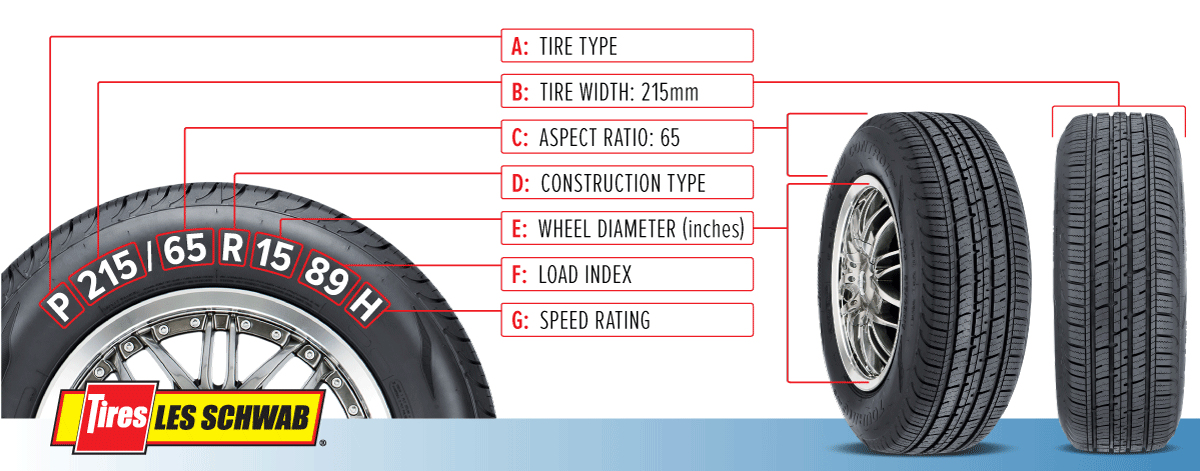Your quad is a do-anything machine. ATV’s are great for getting things done and for recreation too. But now you’re looking at your tires. Maybe you’ve blown one or they’re getting bald. Or maybe you just want a more aggressive tread pattern and a bigger tire. The problem is you’re a little lost when it comes to your ATV tire size.
How big can you go? Should you go big? How do you even know what all these numbers represent?
Don’t worry, we’ve got you covered. We’ll answer all those answers and more in this comprehensive guide.
How Do You Read ATV Tire Sizes?So, you’re shopping around for tires and you see one listed with a size like 26×10-12. Or, worse yet, you find something listed like 206/80R12.
What the heck does all that mean?
First, you need to figure out if you’re dealing with standard or metric ATV tire sizes.
ATV Tire Sizes: Standard Tire Sizing ChartStandard format is much more common on ATV tires than metric. You might see a tire size written 26×10-12 or, occasionally, 26x10x12. This format is pretty straightforward. It uses three numbers to sum up the size:
If you see a tire size that looks like this: 205/80R12, you know you’re dealing with metric. The metric format is exceedingly rare for ATVs and odds are you’ll never come across it. But if you do, the letter thrown in the middle of those numbers is a dead giveaway. In metric, you always have three numbers and a letter:
There may be other numbers and letters before and after these, but they’re not important for understanding your ATV tire size.
Breaking Down ATV Tire Sizes by the NumbersKnowing how to read those tire sizes is just the first step.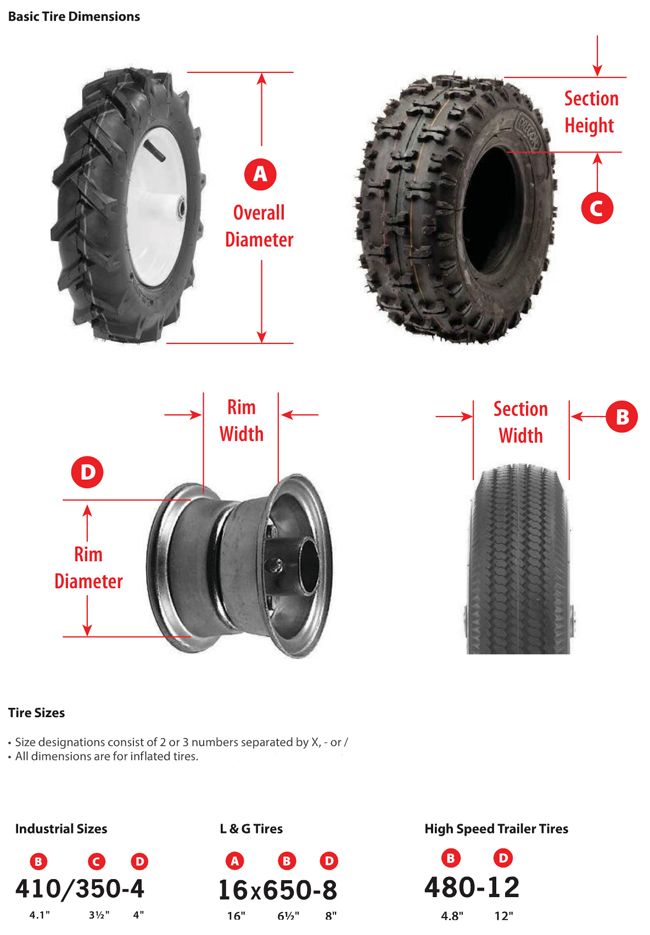 You really need to know how to use them. Is 26 inches a reasonable diameter for your quad? What kind of width do you need?
You really need to know how to use them. Is 26 inches a reasonable diameter for your quad? What kind of width do you need?
When you’re considering replacing all of your tires, you’ll want to make sure you get something that will actually fit on your stock vehicle.
Your typical ATV tire diameter fits within a range of about 20 inches for the smallest machines to about 30 inches for your more factory mud-equipped machines.
Basically, your quad will typically fit into one of few categories:
Keep in mind that you’ll want to keep within a couple inches of your stock tire size. If you go too big, you’ll start to rub on your fenders (among other issues). If you go small—well, that’s just silly.
Tire width is easier to understand. Choosing the right tire width has a lot to do with your own preferences and riding style.
A wider tire tends to give you a flatter tread pattern and more grip. A narrow tire gives you a little more control.
ATV’s usually have a wider tire on the rear than on the front to get the best of both tires. A typical rear tire on a quad will be 10 to 11 inches wide while a front tire will be 7 to 8 inches wide.
But matching your tire width to your riding style isn’t the only thing you need to consider. You also need to make sure it’ll physically fit on your chosen wheel. There are two main ways to make sure it’ll fit.
This one is non-negotiable. You have to make sure your tire’s wheel diameter matches your actual wheel diameter.
You have to make sure your tire’s wheel diameter matches your actual wheel diameter.
Most off-road wheels tend to be 10 to 12 inches in diameter—which is convenient considering most off-road tires are designed to fit those wheels. That’s a good size as it gives your tire plenty of cushion between the tread and rim, which results in smoother rides and more protection for your rims.
Of course, you can end up with bigger wheels if you have bigger tires, but we’re getting ahead of ourselves.
Choosing the Right Size Tires for Your ATVYou don’t need any old tire. You have to choose the perfect ATV tire size for you. After all, you ride your own way and have your own needs.
We’re going to simplify ride style to three main types:
For a workhorse ATV, it’s not a bad idea to stick with stock. It’ll give you the expected traction and power you need.
Trail riding, like dune riding, means you want to go fast.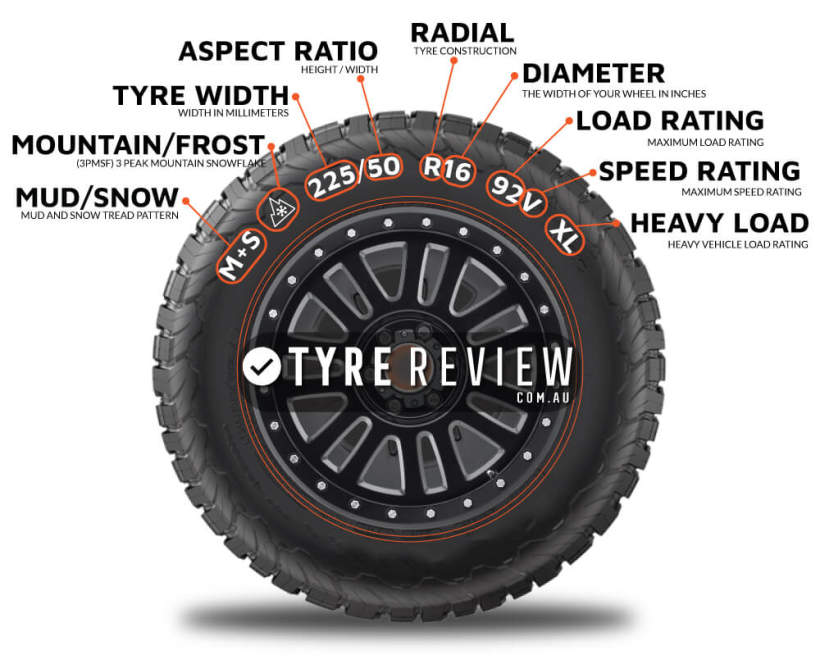 For that, a wider, flatter tire will keep you gripping and in control. If you ride in the mud, you might want to go with something bigger and narrower along with an aggressive tread pattern.
For that, a wider, flatter tire will keep you gripping and in control. If you ride in the mud, you might want to go with something bigger and narrower along with an aggressive tread pattern.Trails and dunes demand high traction, and you get that by going wider. You don’t necessarily need a taller tire, but a wider one will give you the grip you need.
Dominating rock gardens and taking on bounty holes is done best with a big tire. But going big isn’t as simple as just buying the biggest tire you see.
Can I Put Bigger Tires on My ATV?The short answer is yes.
Here comes the long answer.
Every ATV has a theoretical maximum tire size it can fit without modifying the suspension. It’s typically about one to two inches bigger than your stock tires. So if your ATV came with a 27-inch tire, you could probably fit a 29-inch tire without too much trouble.
But what if you want to go bigger?
That takes some work. You’ll either need to invest in a lift kit or some offset A-arms. These types of kits will often tell you what the max tire size is when you have them installed.
These types of kits will often tell you what the max tire size is when you have them installed.
You can’t go big without some consequences though. Namely, you’ll lose torque due to the increased diameter (big tires like a high-gear kit!) and the extra weight. The weight can also put extra strain on your clutch and shorten the life of your clutch belt.
Luckily, you can get your torque back with a transmission gear reduction or GDP Portal Gear Lift (which has a gear reduction built in).
You can also bolster your clutch with heavy-duty drive belts and eek out even more torque with a clutch kit.
So now that you’re equipped with knowledge, go equip yourself with some tires. Get the ATV tire size you want, and ride with confidence.
RELATED CONTENT: ATVs38 tires15
Share
10
ATV tires come in many different sizes, shapes, treads, and materials.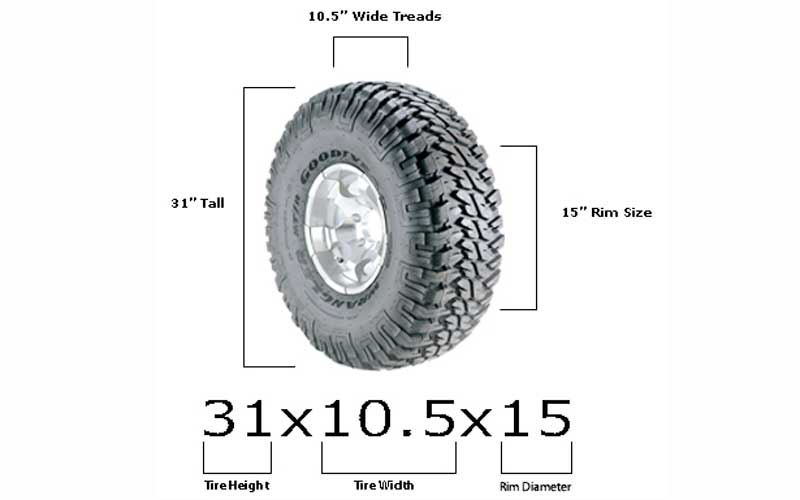 It can be hard to weed through all the options to find a tire suited for your style of riding. Getting the right tire for your environment will increase handling, cornering, and braking depending on the terrain you ride.
It can be hard to weed through all the options to find a tire suited for your style of riding. Getting the right tire for your environment will increase handling, cornering, and braking depending on the terrain you ride.
Replacing your tires when they need it helps performance as well, the difference between used and new tires is noticeable right away. It’s worth it to spend the extra money to get a quality set of tires, but you don’t need to spend a fortune to get a good tire that will last you years of riding. Here are some things to consider when looking for a new set of tires for your quad.
The first thing to find out is the size of tires your ATV takes. You could always buy different wheels for your ATV and match the tires to the rims, but lets assume you just want to replace the tires. Tire sizes are usually shown in a three number format separated by a dash or an x or both, like this, 25×10-12 or 25x10x12 or 25-10-12.
The first number is the tire height when the tire is inflated.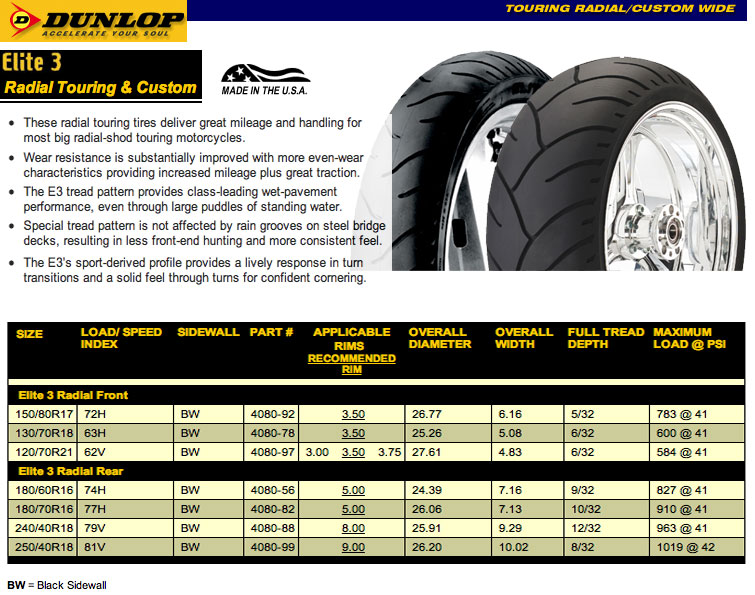 The second number is the tire width when fully inflated. And the third number is the wheel diameter. So for a tire reading 25×10-12, the tire is 25″ tall, 10″ wide, and will fit on a 12″ rim. If your tire is a radial construction tire, you might also notice an R in there too, like this, 25-10R12.
The second number is the tire width when fully inflated. And the third number is the wheel diameter. So for a tire reading 25×10-12, the tire is 25″ tall, 10″ wide, and will fit on a 12″ rim. If your tire is a radial construction tire, you might also notice an R in there too, like this, 25-10R12.
If you want to get the stock tires for your quad, check your users manual. Or to replace existing tires that are worn out, simply check the side wall of the tire you want to replace to find its size.
Now that you know what size of tires you need, you can decide what type of tire suits you best. This depends on what type of riding you do most often, and what type of rider you are. The types of tires you can expect to see will fall into one of these categories: All-Purpose, Off-Road, Motocross, Mud, or Sand.
For any of these types of tires you want to look at the ply and tread depth. The tread depth is just how deep the tread of the tire is. The tire will grip better and last longer the more tread depth there is. The tire ply is how many layers of material the tire is made out of. The more ply, the stronger the tire will be and the more resistant to punctures it will be. A stock tire is around 4-6 ply with a tread depth around 0.5-0.6 inches.
The tire ply is how many layers of material the tire is made out of. The more ply, the stronger the tire will be and the more resistant to punctures it will be. A stock tire is around 4-6 ply with a tread depth around 0.5-0.6 inches.
If you want to keep things simple, and be able to ride on all of these terrains without having to change tires out, I would go with the All-Purpose tires. These are usually what a new ATV comes stock with on it anyways. If you do decide to go with these tires, get a tread depth at least 0.5″ or more. That way the tires will last a while.
All-Purpose tires are by far the most popular and most purchased type of tire for four wheeling. You can go from muddy river bed to packed down trail and experience the same performance from your machine. Of course, mud tires will beat these in the mud any day. But for the average rider, All-Purpose tires are the way to go.
I found this Set Of 4 Wanda ATV Tires (link to Amazon), for under $250 for all 4 tires. Wanda makes a good all terrain tire, and the reviews are excellent for this one. It has a heavy 6 ply rated nylon material to help resist punctures. Just make sure to select your size tires when ordering. I have seen tires selling for around 100 dollars a piece on Amazon, so this is a pretty good deal to replace all your tires in one go.
Wanda makes a good all terrain tire, and the reviews are excellent for this one. It has a heavy 6 ply rated nylon material to help resist punctures. Just make sure to select your size tires when ordering. I have seen tires selling for around 100 dollars a piece on Amazon, so this is a pretty good deal to replace all your tires in one go.
Off-Road tires are similar to All-Purpose tires in a few ways. The only real difference is that the Off-Road tires are made with stronger tread, and are usually more durable. They need to be in order to handle the off road trails.
Because you can encounter everything from snowy mountain trails to sandy wooded trails, Off-Road tires are basically stronger all terrain tires. The Kenda Kutter XC Tires are a good mid range quality tire for off road use.
ATV motocross is usually an all man made course. The soil is loose, so you would want a tire that has stiff knobs to help you get through corners. But you also want a spaced out tread pattern to help with grip during acceleration.
But you also want a spaced out tread pattern to help with grip during acceleration.
Grip becomes extremely important when there are jumps and other obstacles that could cause injury. The Maxxis Razr Tires are great for motocross, but I would only use these on tracks you are familiar with and know there aren’t any rocks or logs that will puncture this 4 ply tire.
These types of tires usually have deeper lugs than most of the others. Mud tires need to give you traction in the worst case scenarios. The tires have these big knobs on them which help dig you out of mud or snow. They will get you through more muddy areas than an all terrain tire will.
These Interco Swamp Lite ATV Tires are just plain cool looking. They are 6 ply tires and come as a pair. Be sure you get the right size for your wheels.
Sand tires are only really needed if you plan on riding in the dunes. Which by the way is a blast, it’s worth trying out. Usually the rear wheels will be like paddles to push you through the sand, and the front wheels will be smooth except for a rib down the center for steering.
Usually the rear wheels will be like paddles to push you through the sand, and the front wheels will be smooth except for a rib down the center for steering.
Sand tires can be expensive, and for only really being useful for riding in the dunes, it’s hard to justify. You could probably be fine with your all purpose tires, but you’ll get sick of getting stuck and pulling yourself out. Here is an example Maxxis Razr Blade sand tire to check out.
How do you know when you need to replace your ATV tires? There’s no point wasting money on new tires until you need to right? Usually you’ll be able to feel the tires getting worn out. You might notice your tires not gripping as well as they used to. You can tell when taking corners that the back end may be sliding out more than it used to and things like that.
Tires usually last about five years, so if you’ve had them for four or five years it might be time to have a look at them. Tires should look dark black, after you wipe the dirt off them. Old tires will have the knobs rounding down, which reduces grip. And they will look weathered and faded, either from the sun or because they are old.
Old tires will have the knobs rounding down, which reduces grip. And they will look weathered and faded, either from the sun or because they are old.
If you notice any cracking in the rubber, you might need new tires. The tires rubber material gets dried out and cracks over time weakening the tire.
TIP: Keep your tires inflated to the proper psi, that will help your tires last longer and your quad will handle better. A good standard ATV tire pressure is around 5 psi for normal riders. If you want to learn more about tire pressure or even customize your tire pressure to fit your style of riding check out the ATV Tire Pressure article here.
Taking care of your ATV wheels is just as important as the tires. If you buy brand new excellent quality tires and put them on cracked rims, they could pop your brand new tires. There are a few different types of rims and they have their respective purposes.
The most common type of ATV rim is made out of steel.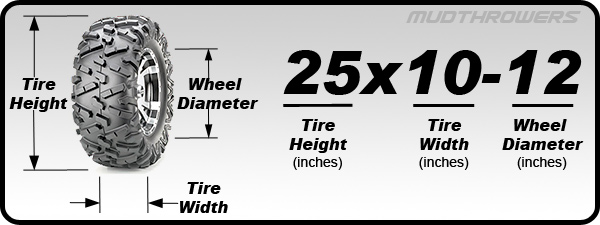 That’s because they are cheap and easy to make, but they are also heavy. Heavy wheels aren’t good for every situation. For example, if you plan on going sand riding in the dunes, you want a light weight wheel to put paddle tires on. Aluminum alloy or magnesium alloy rims are recommended for the dunes. People also upgrade their rims based on their riding style and preference. Larger wheels will give you more power, but smaller wheels will give you more speed.
That’s because they are cheap and easy to make, but they are also heavy. Heavy wheels aren’t good for every situation. For example, if you plan on going sand riding in the dunes, you want a light weight wheel to put paddle tires on. Aluminum alloy or magnesium alloy rims are recommended for the dunes. People also upgrade their rims based on their riding style and preference. Larger wheels will give you more power, but smaller wheels will give you more speed.
If you aren’t going to be doing any professional racing or riding in extreme terrain, the normal stock rims are probably fine. But if you need to replace them, or want to upgrade to a lighter wheel, you should know how to read your wheel size.
The wheel size is usually stamped right into the rim itself. It might look something like this, 8×8,3+5,4/110. The first 8 is the diameter of the wheel, that means you need a tire with that diameter to fit it. The second 8 is the width of the wheel. The 3+5 is the offset of the wheel, this wheel would be 3″ off center and 5″ offset to the outside.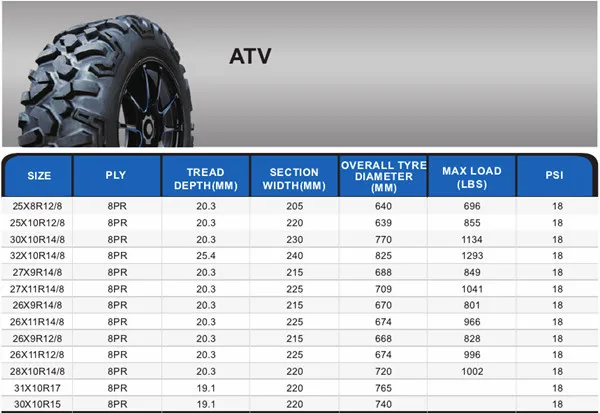 I’ll tell you about offset in a bit. The 4 is how many bolt holes (lugs) in the rim, and the 110 is the spacing of bolt holes in millimeters.
I’ll tell you about offset in a bit. The 4 is how many bolt holes (lugs) in the rim, and the 110 is the spacing of bolt holes in millimeters.
Your ATV wheel offset can be changed so that the quad will handle how you like it to. If you’re not having handling problems with your ATV, you probably don’t need to worry about this. But if you don’t like how it handles, it could be too loose or too stiff, then you can change the width of the front or rear end to handle how you want it to.
There is an inner wheel half and an outer wheel half as they align with the hub. Our example will be a 3+5 wheel offset. As you can see in the picture below, the 3 represents 3″ on the inner wheel half, and the 5 means 5″ on the outer wheel half.
The inner wheel half is the side facing the ATV, and the outer is the side facing away from the ATV. The hub is where your rim mounts to your quad. Adjusting the wheel offset is basically bringing the wheel closer or further away from the ATV.
Some people will get rims with a negative offset like 2+5 in order to widen the stance of their quad. This is mostly done for looks rather than handling. Although some quads with a straight axle in the rear take a 2+5 wheel, the most common wheel offset is 5+2. Almost all utility ATVs and UTVs will have a 5+2 offset, as well as any quad with independent rear suspension.
This is mostly done for looks rather than handling. Although some quads with a straight axle in the rear take a 2+5 wheel, the most common wheel offset is 5+2. Almost all utility ATVs and UTVs will have a 5+2 offset, as well as any quad with independent rear suspension.
Sharing is caring!
05/17/2018
The numbers written on the side of the rubber tire can tell the owner of the ATV everything that interests him. And if you are for some If you don't know what these mysterious numbers mean, then you can be mistaken when choosing the next set of tires. But tires directly determine whether it will go technique further or not. So, in this article you will close all the questions on about the decoding of size ATV tire .
All tires have their own basic parameters - this is the width, height and diameter.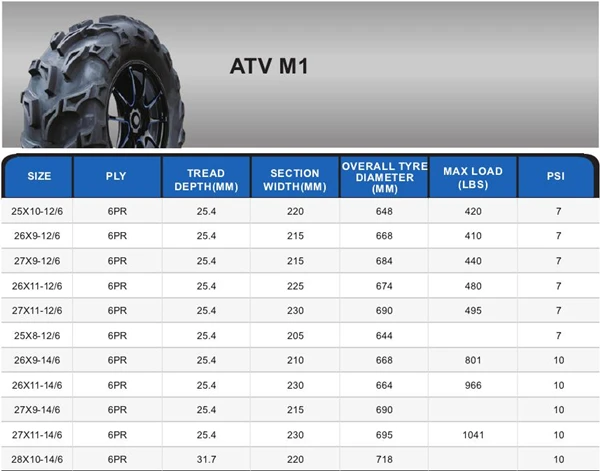 The value of these parameters is mainly measured in inches. Exists two units:
The value of these parameters is mainly measured in inches. Exists two units:
1) If you have ATV, then this is for you. English version is the most common number system that is used when determination of tire dimensions on ATVs. All measurements here are in inches. (1 inch equals 2.54 cm). For example, the size indicated in English classification looks like this - 25x8x12 . Let's take a closer look at the meaning of each digit:
- The first digit 25 shows the height of the tire in inches;
- The second digit 8 indicates the width of the tire in inches;
- The last, third digit 12 indicates the diameter of the wheel disk, it is also measured in inches. Disc diameter on each ATV can be different. Therefore, be careful before you buy tires for ATV, see what regular disks are installed on your vehicle.
And a very important point worth noting. Often our customers ask themselves: “If I have a tire size of 20x10x10, can I put instead of them 20x11x10? The answer is yes. First, you can put rubber on regular wheels with a size exceeding 1 inch in height and width. Secondly, if you want tires even wider, then for this you will need to buy other disks. But again, there are limitations. On discs of other diameters, you can install rubber, the largest is only 2 inches in height and width.
First, you can put rubber on regular wheels with a size exceeding 1 inch in height and width. Secondly, if you want tires even wider, then for this you will need to buy other disks. But again, there are limitations. On discs of other diameters, you can install rubber, the largest is only 2 inches in height and width.
These two rules must be strictly observed, otherwise, if you try to put tires of an unacceptably large size, this may adversely affect on a quad bike. After all, the rubber will be larger and, accordingly, heavier, which does not fit the technical parameters of the ATV. In production ATVs take into account all the characteristics, so manufacturers of ATV equipment I don't recommend using bigger tires at all. But if you do decided to increase the size of tires, call our toll-free number, we we will help.
2) Also there is another version - metric . Here the dimensions are indicated in percentage and millimeters. For example, size specified according to the metric classification - 205/80 Rx12 .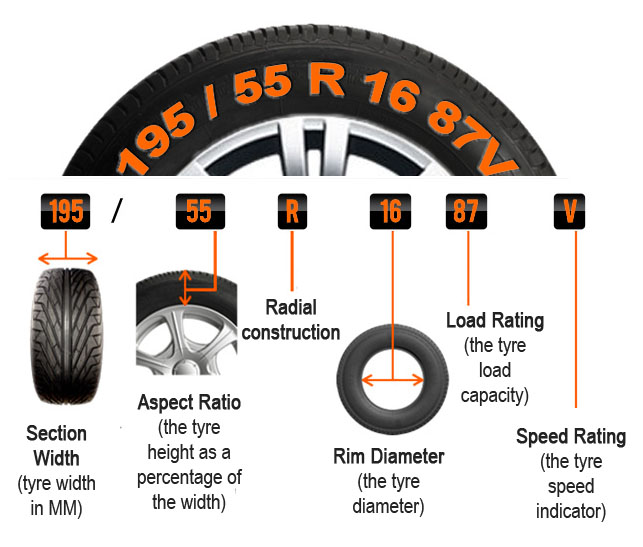 Such designations are usually used on automobile tires. Let's see what's what:
Such designations are usually used on automobile tires. Let's see what's what:
- The first digit of 205 shows the total tire width in millimeters. Converting this value to inches, we will just get the number 8 (in the English version is 8 inches wide).
- The second digit 80 indicates the ratio of the height of the tire to its width, measured as a percentage. After doing some mathematical manipulations, we get the number 25 (in the English version, the height is equal to 25 inches).
- The number 12, as in the English version, shows the size disk in inches.
- Well, the letter R means that our tire is radial.
The most important thing to remember from the article is that it is not recommended to install tires of huge sizes that do not correspond to the parameters your ATV . If you want to change the tires on your vehicle, give us a call. we will help.
05/11/2014
In the ATV world, the tire marking system is in inches. For example, let's deal with the size of rubber 27x9x12
For example, let's deal with the size of rubber 27x9x12
"27" - the first number in the row will be the wheel diameter in inches. It is worth recalling that 1 inch is equal to 2.54 cm. This marking system is very convenient in that it indicates the diameter of the wheel, taking into account the size of the rim. For example, a wheel marked 27x9x12 will not differ in diameter from a wheel marked 27x9x14, just a 14-inch wheel will be 2.5 cm smaller.
"9" - the second value gives an indication of the width of the tire and is also expressed in inches.
"12" - The diameter of the disc on which the tire is mounted.
Tread pattern
1. Universal tyres.
ATV tire with this tread has a shallow but aggressive tread pattern. Such rubber behaves very well on dry soils, forest rolled paths, primers. It is used in mountainous suitability (stones, crushed stone). She has excellent performance on sand and loose soils. In mud or swampy areas, such rubber rides no worse than mud.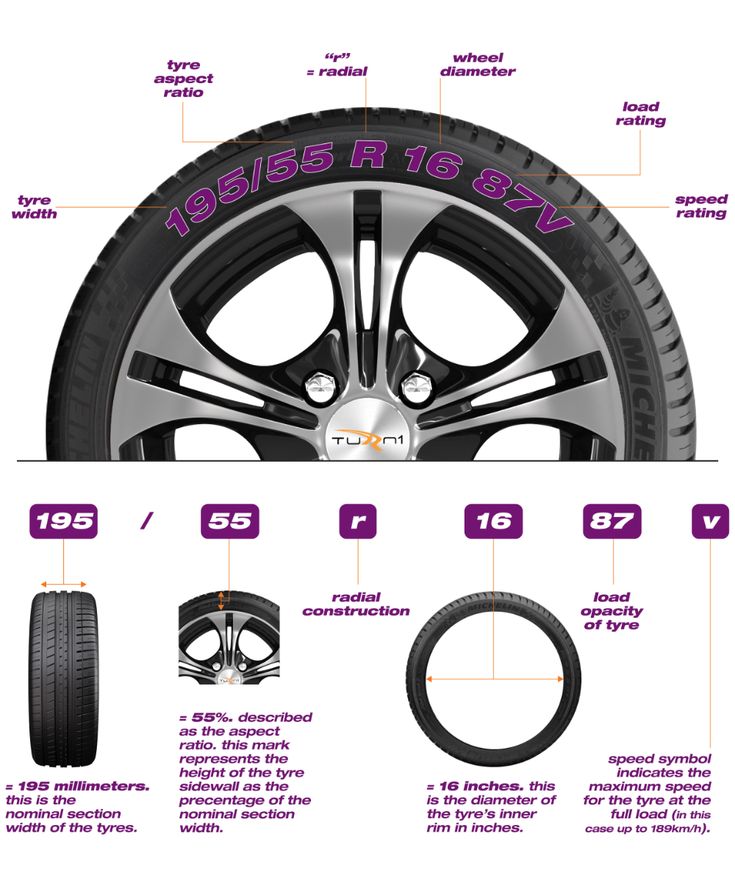 She does not burrow and confidently storms the swamps, if the gas is dosed correctly. It does not need to be “pulled in” like mud tires, you need to work with gas correctly and try to go through difficult sections “on the move”. Universal rubber, always lighter and softer than mud. It's much more comfortable to ride and handling is better. The height of the lugs for universal rubber should be at least 20 mm, the distance between them should be at least 20 mm and not more than 30 mm. The shape of the lugs (pyramid) and the distance between them provide good self-cleaning. The standard tires of many ATVs do not fit the description of universal rubber, mainly because of the small tread height.
She does not burrow and confidently storms the swamps, if the gas is dosed correctly. It does not need to be “pulled in” like mud tires, you need to work with gas correctly and try to go through difficult sections “on the move”. Universal rubber, always lighter and softer than mud. It's much more comfortable to ride and handling is better. The height of the lugs for universal rubber should be at least 20 mm, the distance between them should be at least 20 mm and not more than 30 mm. The shape of the lugs (pyramid) and the distance between them provide good self-cleaning. The standard tires of many ATVs do not fit the description of universal rubber, mainly because of the small tread height.
2. Mud tires.
Mud tires have an aggressive tread consisting of large blocks and a large distance between them. These tires are specially designed for heavy off-road driving. Typically, the tread of mud tires has a herringbone pattern. Such a pattern behaves well in muddy mud, a swamp and contributes to good self-cleaning.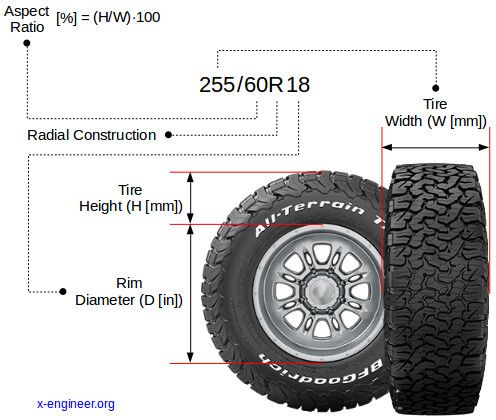 When driving on loose soils, you need to be careful, since such a tire instantly digs in when slipping. The tread height of mud tires is from 25mm to 30mm. The distance between the central lugs can be up to 100mm depending on the tire size. There are exotic tires with a tread height of 50mm. Such large lug spacing seriously reduces ATV handling on hard and loose ground. In addition, mud tires are always hard, which makes driving on hard ground uncomfortable. Mud tires weigh much more than universal ones. If tires of the same size are weighed, then universal tires weigh almost 20% less
When driving on loose soils, you need to be careful, since such a tire instantly digs in when slipping. The tread height of mud tires is from 25mm to 30mm. The distance between the central lugs can be up to 100mm depending on the tire size. There are exotic tires with a tread height of 50mm. Such large lug spacing seriously reduces ATV handling on hard and loose ground. In addition, mud tires are always hard, which makes driving on hard ground uncomfortable. Mud tires weigh much more than universal ones. If tires of the same size are weighed, then universal tires weigh almost 20% less
3. Tire pressure.
All ATV tires are low pressure tires. On average, for normal driving, tire pressure should be maintained between 6 and 8 psi. If you intend to use the ATV only in swampy areas, then the pressure must be reduced. With a decrease in tire pressure, the area of the contact patch increases, and the specific pressure on the ground decreases. At the same time, it should be taken into account that on hard ground the handling of the ATV will noticeably decrease, and the probability of wheel disassembly will also increase.